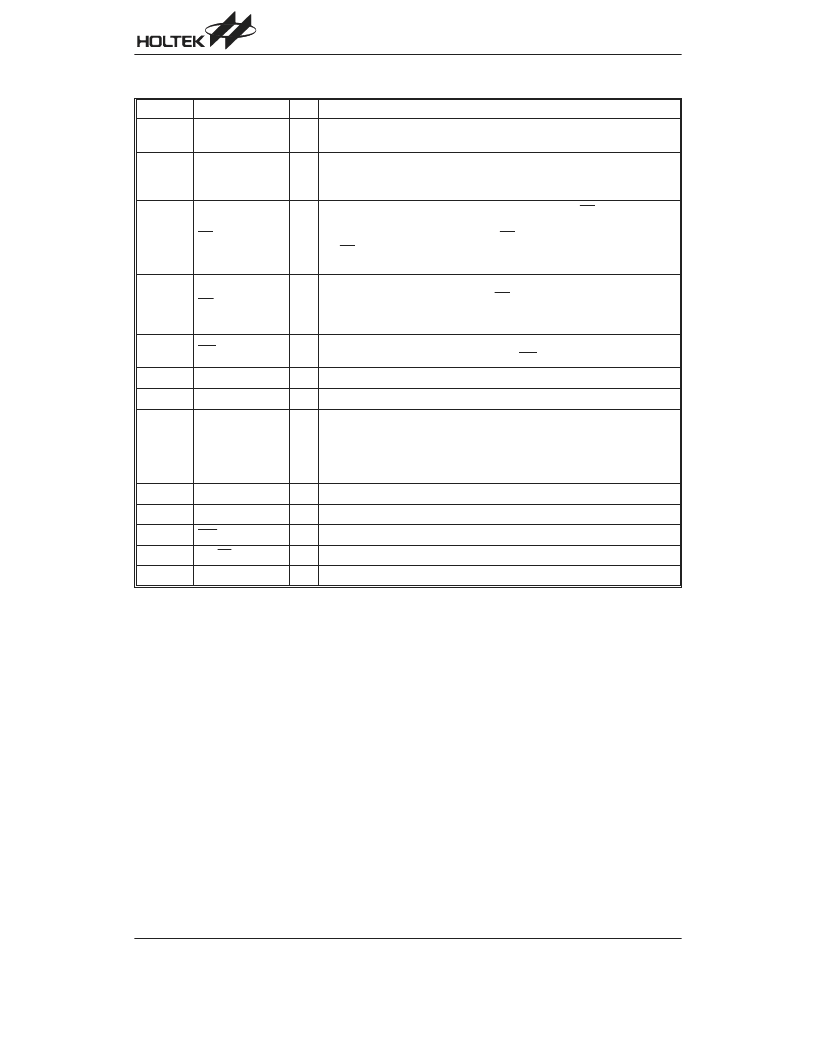- 您現(xiàn)在的位置:買賣IC網(wǎng) > PDF目錄385397 > HT1660 (Holtek Semiconductor Inc.) 96 x 32 LCD Controller for I/O MCU PDF資料下載
參數(shù)資料
| 型號: | HT1660 |
| 廠商: | Holtek Semiconductor Inc. |
| 英文描述: | 96 x 32 LCD Controller for I/O MCU |
| 中文描述: | 96 × 32 LCD控制器的I / O控制器 |
| 文件頁數(shù): | 5/18頁 |
| 文件大?。?/td> | 197K |
| 代理商: | HT1660 |

Pad Description
Pad No.
Pad Name
I/O
Description
1~33
87~149
SEG63~SEG95
SEG0~SEG62
O
LCD segment outputs
34~49
71~86
COM31~COM16
COM0~COM15
O
LCD common outputs, under 112 16 command mode, COM16~COM31 will
share to SEG96~SEG111. COM31/SEG96, COM30/SEG97, COM29/
SEG98....., COM18/SEG109, COM17/SEG110, COM16/SEG111
50
CS
I
Chip selection input with pull-high resistor. When the CS is logic high, the
data and command read from or write to the HT1660 are disabled. The serial
interface circuit is also reset. But if the CS is at a logic low level and is input to
the CS pad, the data and command transmission between the host controller
and the HT1660 are all enabled.
51
RD
I
READ clock input with pull-high resistor. Data in the RAM of the HT1660 are
clocked out on the falling edge of the RD signal. The clocked out data will ap-
pear on the data line. The host controller can use the next rising edge to latch
the clocked out data.
52
WR
I
WRITE clock input with pull-high resistor. Data on the DATA line are latched
into the HT1660 on the rising edge of the WR signal.
53~56
DB0~DB3
I/O
Parallel data input/output with a pull-high resistor
57
VSS
Negative power supply for logic circuit, ground
58
59
OSCI
OSCO
I
O
The OSCI and OSCO pads are connected to a 32.768kHz crystal in order to
generate a system clock. If the system clock comes from an external clock
source, the external clock source should be connected to the OSCI pad. But
if an on-chip RC oscillator is selected, the OSCI and OSCO pads can be left
open.
60
VDD
Positive power supply for logic circuit
61
VLCD
I
Power supply for LCD driver circuit
62
IRQ
O
Time base or Watchdog Timer overflow flag, NMOS open drain output.
63, 64
BZ, BZ
O
2kHz or 4kHz frequency output pair (tristate output buffer)
65~69
T1~T4, T000
I
Not connected
Absolute Maximum Ratings
Supply Voltage...........................V
SS
0.3V to V
SS
+5.5V
Storage Temperature............................ 50 C to 125 C
Input Voltage.............................V
SS
0.3V to V
DD
+0.3V
Operating Temperature........................... 25 C to 75 C
Note: These are stress ratings only. Stresses exceeding the range specified under Absolute Maximum Ratings may
cause substantial damage to the device. Functional operation of this device at other conditions beyond those
listed in the specification is not implied and prolonged exposure to extreme conditions may affect device reliabil-
ity.
HT1660
Rev. 1.00
5
September 16, 2003
相關(guān)PDF資料 |
PDF描述 |
|---|---|
| HT1670 | 128x32 LCD Controller for I/O MCU |
| HT18LG | Electronic Telephone Line Switch |
| HT19LG | Electronic Telephone Line Switch |
| HT2040A | Christmas Light Controller |
| HT23B60 | 60x11 Pixel Data Bank 8-Bit Mask MCU |
相關(guān)代理商/技術(shù)參數(shù) |
參數(shù)描述 |
|---|---|
| HT1660_06 | 制造商:HOLTEK 制造商全稱:Holtek Semiconductor Inc 功能描述:96x32 LCD Controller for I/O MCU |
| HT1660_10 | 制造商:HOLTEK 制造商全稱:Holtek Semiconductor Inc 功能描述:96x32 LCD Controller for I/O MCU |
| HT1670 | 制造商:HOLTEK 制造商全稱:Holtek Semiconductor Inc 功能描述:128x32 LCD Controller for I/O MCU |
| HT1670_10 | 制造商:HOLTEK 制造商全稱:Holtek Semiconductor Inc 功能描述:128x32 LCD Controller for I/O MCU |
| HT16C21 | 制造商:HOLTEK 制造商全稱:Holtek Semiconductor Inc 功能描述:RAM Mapping 20*4 / 16*8 LCD Driver Controller |
發(fā)布緊急采購,3分鐘左右您將得到回復(fù)。